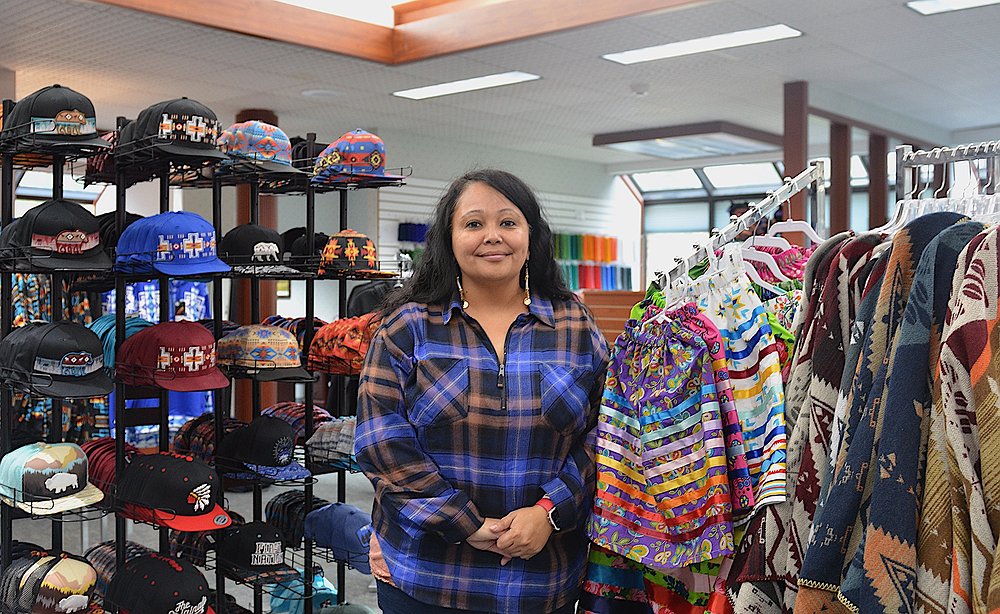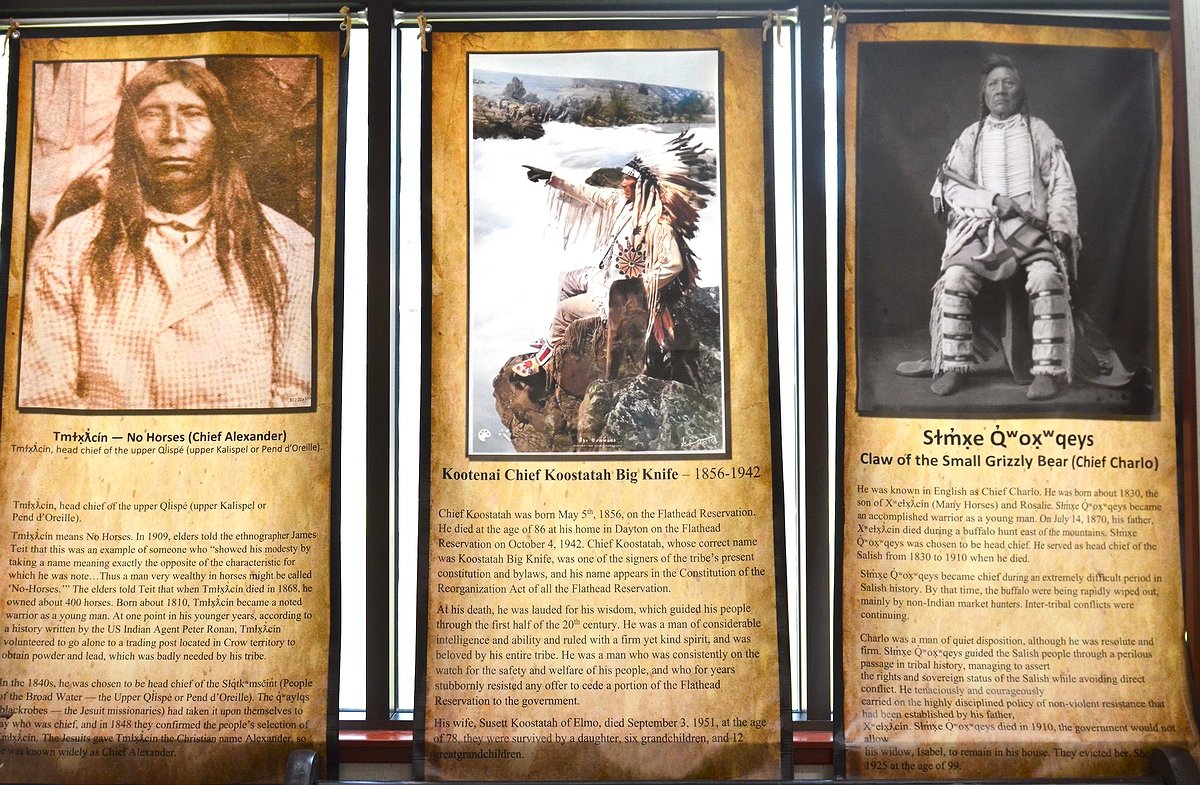Resurrection: Three Chiefs Cultural Center returns to Pablo
For Marie Torosian, director of Three Chiefs Cultural Center in Pablo, hope rises from ashes. It lives in every moccasin, headdress, beaded bag or vest that survived the arson-caused fire that demolished the People’s Center Sept. 6, 2020.
And hope inhabits the new, temporary home of Three Chiefs Cultural Center, which was recently relocated from the Allard Building in St. Ignatius to the former Glacier Bank on Major Houle Road in Pablo.
“Our staff here, we have big dreams,” Torosian said in a recent interview. “Our plan and our goal is to continue to move forward, continue to recover – not only the artifacts and the collections, but ourselves. And to get a new building built, a new state-of-the art building that has fire suppression.”
For now, though, the staff is settling into their new digs. Administrative assistant Loushie Charlo manages a gift shop brimming with beads, fabric and local beadwork, and gift items ranging from hats and jackets to toys and jewelry, all purchased from Native-owned businesses across the country.
A small exhibit area displays some of the objects that survived the fire, a photographic history of the Confederated Salish and Kootenai Tribes, and images of the three chiefs that inspired the center’s new name. The downstairs area is being transformed into a secure storage area, with a large classroom, a larger exhibition space, and an area devoted to restoration of artifacts damaged by the fire.
The fire’s legacy is inescapable. Prior to our visit, Torosian was sorting through photographs on her computer of events at the People’s Center, still looking for evidence of some of the items that were lost while submitting the final insurance claims.
“It's been really difficult going through and seeing all these activities and things that we had, and all the fun and everything we did there at the People's Center,” she said.
It also evokes memories of that devastating night in 2020. The arsonist effectively barricaded himself in the building, and lit fires in the gift shop, repository and office area. The structure, which was constructed in the early 1990s, had no fire suppression system, and the blaze killed the arsonist and destroyed 75% of the collection before fire crews could break in and quench it.
Strangely, the front, from Highway 93, looks almost intact. But the back of the building reveals the devastation that occurred. Because a life was lost there, says Torosian, it won’t be rebuilt.
“We were there when the fire was taking place, when the firefighters were fighting the fire and when they removed that young man's body from the building,” she says. “We know what transpired in that building …. We just don't ever want to be there again.”
Beginning to rebuild
After the fire, the staff regrouped at Salish Kootenai College to begin the painful task of assessing the damaged items. Oddly, many of the artifacts on display survived, while most of those stored in the vault were lost, including eagle feather headdresses, buckskin coats, beaded buckskin moccasins, gauntlets, gloves and a beaded bag collection that had traveled around the United States in the early 2000s.
Conservators from across the nation arrived to help sort through the items that suffered from smoke, fire or water damage. Some of the salvaged artifacts are stored by the Montana Historical Society in Helena, while others were sent to Ancient Artways in Wilsall, where trained conservator Nancy Fonicello is bringing them back to life. Kalispell artist Joe Abbrescia has helped restore paintings damaged by the blaze, Jennifer McGlinchy-Sexton restored photos, negatives and historical papers, and Jack Lyons repaired a historic church bench and two showcases.
In the midst of that process, the Confederated Salish and Kootenai Tribes arranged to lease the Allard Building in St. Ignatius from Stuart Morton as a temporary home for the center. As the staff began to regroup, Torosian suggested a name change.
“I told the ladies I thought it would be really good if we chose a name that would represent all three tribes equally,” she recalls. “We're three distinct tribes, and traditionally we were guided and governed by our chiefs, one from each tribe.”
Three Chiefs honors that tradition, and specifically celebrates the legacy of Salish Chief Charlo (Claw of the Little Grizzly), Pend d'Oreille Chief Alexander (No Horses) and Kootenai Chief Koostatah (Big Knife).
“It’s not that we're leaving the People's Center behind but we're leaving behind what happened. And we're moving forward,” Torosian says of the name change. The new name also reflects the support from “our ancestors, our people, from the community, and we're building on those to get us back up and going again.”
While the location along Highway 93 in St. Ignatius was conducive to visitors, the space wasn’t ideal, says Torosian. After the Tribes bought the former Glacier Bank, they decided to move the Three Chiefs Cultural Center to that location this fall, with some extensive remodeling.
“The first thing I asked for was fire suppression,” says Torosian. When the downstairs is complete, items that are stored by the Historical Society will be returned.
“We'll bring those back here and they'll be stored here, cared for here, and then just rotated on exhibit, making sure that they're safely exhibited,” she added. “They're going to be a lot more fragile than they were before.”
Cultivating resilience
In the basement of Three Chiefs, curation technician Geri Hewankorn continues to restore some of the less severely damaged items, removing smoke and soot from rawhide and beadwork. Her main restoration tools are rubbing alcohol, cotton balls and toothpicks “to get into the little tiny spaces.”
Even though it’s very time- and labor-intensive work, Hewankorn says she enjoys her endeavors “because it's our history. Because it's the story of our people and it's really heartbreaking to think of the stuff that we lost.”
Hewankorn began her career at the People’s Center as a clerk in the gift shop and was encouraged to learn curation. She began to take online courses and eventually enrolled in Museum Studies at the Institute of American Indian Arts in Santa Fe. She’s just a semester short of earning her bachelor’s degree and hopes to eventually put it to use in “a brand-new awesome facility that I can grow.”
Meanwhile, she hopes to begin rebuilding the collection, both by inviting tribal members to share artifacts in the remodeled exhibition space, and by seeking grants that would allow the center to purchase historical items.
She also plans to host exhibits by high school artists in hopes the exposure might encourage them to pursue a career in art or museum studies.
“I would love for somebody to get into the museum field because I'm not getting any younger,” she adds.
Nadia Adams, education coordinator, is looking forward to having a larger area for classes in the basement of the building, after teaching beading in the break room for the last few months.
She joined the staff in May and says her role “is to educate in any way I can and support my community in any way I can.”
“If you want to learn how to make outfits, beadwork, if you want to learn history – anything that you want to learn – I'm going to help provide it or find someone who can,” she adds.
Torosian is proud of her staff and their resilience. “We all felt the anger. We all felt the hurt and the pain and the struggle to get back,” she says. And yet, finding a path through hardship is what tribal people have done for generations.
“Our ancestors have been through a lot worse, and they still took steps forward to protect our people and to protect our traditions and even our languages,” Torosian says.
“We think of our ancestors and it's for them and it's for our future. We want our children to continue to learn our traditions and our languages and everything about our people. And here at Three Chiefs we can do that, we can share those traditions. You know – our songs and dances, our arts and crafts, our histories.”
Three Chiefs is open 8 a.m.-5 p.m. Monday through Thursday and 9 a.m.-5 p.m. until summer, when Saturdays are added to the mix. For more information, call 406-675-0160 or visit threechiefs.org.









